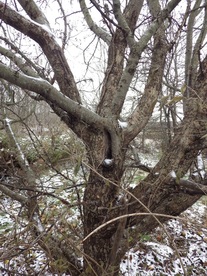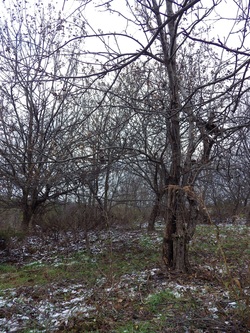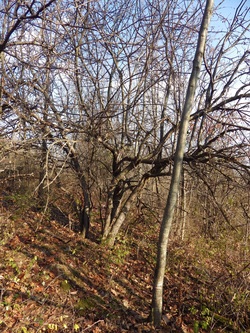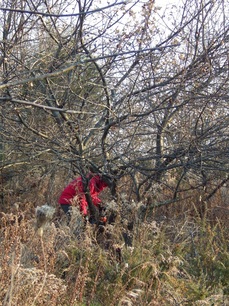 Unless they go bad in the heart, apple-trees can live a very long time. They'll turn wild, their branches winding around one another like tangled arms, rubbing raw spots through the bark when the wind blows. The trunks sprout suckers that reach for the sky and multiply weak joints. Left to their own devices, apple orchards will gradually slurp up the available minerals from the soil. Then they'll muddle on without them. They spend their energy on a multitude of tiny apples, the fruits progressively shrinking. As years pass, the trees come to resemble undernourished miner's children, squinting and wormy and bowed with rickets.  A commercial grower, looking at the 30+ trees on the first rocky knob of our would-be farm might suggest pulling them out and starting over. Or better yet, just begin someplace else –– and make it someplace where the rock base is a few inches deeper below the soil. If that same commercial grower could be lured to the second knob and its even more neglected trees, he might suggest burning it clear. But we are in this apple-growing scheme for curiosity, for the beauty, and for new neural pathways. We are not going to start over. Not yet. We are going to revive the orchards. It should come as no surprise –– since apples have been long cultivated and long revered and (given the nature of human nature) quite often abandoned –– that there's a traditional process for renovating neglected orchards. (Here's the New York Times' take on how-to.)  On a frosty November morning we start our renovation. I carry blackboard chalk and loppers, while Jeff totes the new Tanaka chainsaw and fuel. The seasonal sounds of gunfire (duck- and deer-season) crack across the long valleys and ridges in the chilly distance. All the leaves are down*, revealing the witchy-fingered profile of apple-tree after apple-tree in our new-found groves. (*Not: "...all the leaves are brown, and the sky is gray-ay" but close.) I chalk unlucky young intruder trees with an X so Jeff and the two-stroke Angel of Death shall not pass over them. Then I step away to a safe distance to begin the individual fruit-tree makeovers. It's a battle to reach the trunks, but by lopping and snapping off deadwood, I Stanley-Livingstone my way under each tree's canopy. I circle the main trunk once, twice, more, ducking and sometimes backtracking as branches snag my knitted hat. I'm trying to gauge which water-sucker –– the branches that go straight up like a pipe, hogging the sunlight and branching far higher than I want to climb for fruit -- should go first, and how much barky macrame can be removed.  Sensible tradition says to trim no more than a third of the tree in a year, so it's a question of picking the worst bits to edit away. I leave more chalk X's, and snip-snip at the weakest-looking forks of the long-spreading branches. It becomes a meditative practice, and I hear myself repeating under my breath something I must have read: "favor width over height, privilege strength over volume." Six solid hours later, and we have not finished the first grove. Paul Bunyon's chainsaw blade is dull from use. We've made a dozen rough brush piles and stacks of applewood logs. Good orchard management suggests that the trim would be burned right away, but we are going to leave it for the wildlife over the winter. After all, the deer and the rabbits and the ruffled grouse and who knows what else has been making a good living in this orchard. They kept the thorn-apple and most of the invasive brush at bay for decades. Let them have the twigs for shelter. The logs will be just as fragrant in the spring. The week of work goes very quickly. It feels paradoxically as if there is more left to do at the end of our time than there had been at the beginning. Classic example of the universal law of chore multiplication (tasks multiply to overfill the time allotment). New neural pathways: thanks to a local pal, KD, Jeff learned the valuable knack of sharpening the chainsaw blades. The apple-tree husbandry that crammed my brain to capacity got exercised, at least briefly. We met some neighbors and spotted some wildlife. We leave knowing there's more pruning to do, but it will mostly wait for next fall. In the spring, the blossoms will want thinning and the groves will need a judicious feeding. There's brush to burn and paths to clear. At the end of next summer, if it's been a decent growing season, we'll be figuring out what kinds of apples these are. And gauging whether the renovation is worth continuing.
4 Comments
george a.
3/11/2014 11:39:45 am
To make headway, you need to live there from whenever it gets snow-free until the beginning of the next winter. After about 30 years of that you might catch up...
Reply
Amy
3/12/2014 01:39:42 am
George
Reply
Greg
3/11/2014 03:38:23 pm
Take small bites, you will enjoy it more. are any of the trees of old heritage apples? I am the master of apple cider and would be willing to help with the first batch. I was taught by my grandpa. Such fun.
Reply
Amy
3/12/2014 01:49:41 am
Thanks Greg!
Reply
Leave a Reply. |
About the Blog
A lot of ground gets covered on this blog -- from sailboat racing to book suggestions to plain old piffle. FollowTrying to keep track? Follow me on Facebook or Twitter or if you use an aggregator, click the RSS option below.
Old school? Sign up for the newsletter and I'll shoot you a short e-mail when there's something new.
Archives
June 2024
Categories
All
|
 RSS Feed
RSS Feed
